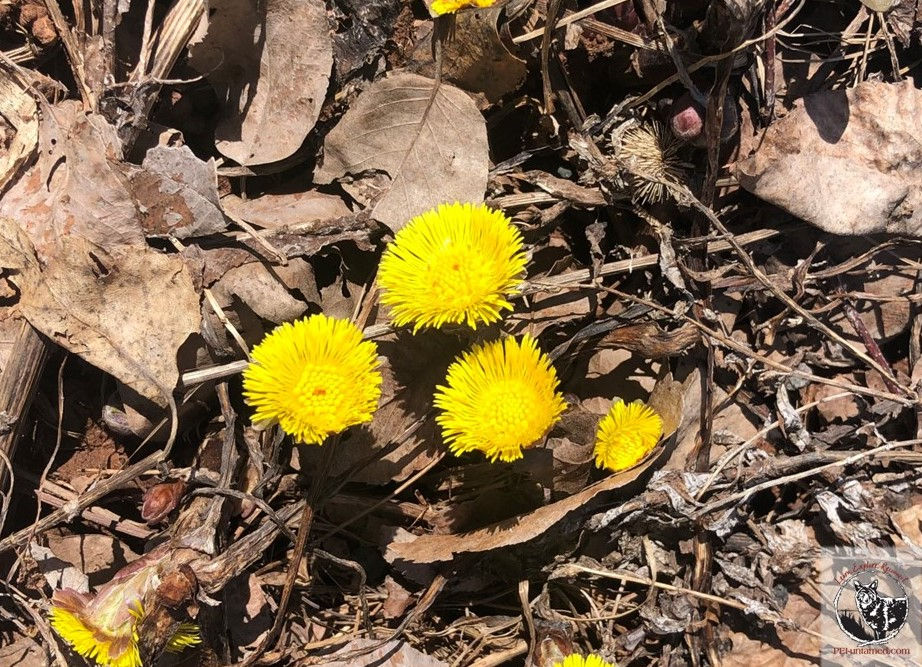Coltsfoot
- katemacquarrie22
- 4 minutes ago
- 3 min read
Some of the Island’s earliest spring wildflowers appear on their plants before the leaves. From the subtle blooms of Red Maple and Beaked Hazelnut to spectacular native Rhodora and ornamental Magnolias, this strategy can be found across many plant families. One showy example is flowering now: Coltsfoot (Tussilago farfara).

Coltsfoot could be mistaken for Dandelion (Taraxacum officinale) at first glance, but a closer look reveals many differences. In addition to flowers appearing before leaves (unlike Dandelion), Coltsfoot blooms earlier, lacks milky juice, and has a very different flower structure, with both rays (those linear florets around the outside of the flower head) and disks (the circular florets in the middle). Take a look at your nearest Dandelion and you’ll see it’s just a collection of ray florets overlapping like shingles on a roof.
Once Coltsfoot is done flowering and setting seed, its distinctive leaves appear. Resembling a horse’s hoof (hence the common name), leaves grow directly from the ground, are broad and roughly heart-shaped, and commonly have dark purple colouring at the top of the leaf stem and around the leaf margin. They are smooth above, covered with white woolly hairs below.
Native to Europe and Asia, Coltsfoot was brought to North America as a medicinal plant in the early 1800s. Flower buds, leaves, and roots have all been used to relieve coughs and lung ailments for thousands of years. (The Latin name ‘Tussilago’ translates roughly as ‘to act on cough’). While modern medical research has confirmed Coltsfoot’s effect against respiratory illness, the plant also contains compounds (pyrrolizidine alkaloids, or PAs for short) that can cause liver damage.
PAs can be found in many plants including local species such as Borage, Comfrey, Joe-pye, and Tansy Ragwort (as well as food such as honey from bees that visited these plants). Documented cases of human harm due to Coltsfoot are few, and most involved consumption of multiple herbs, making a direct link to Coltsfoot difficult. Even so, consumption of Coltsfoot is regulated in some parts of Europe, and Health Canada recommends external use only. A PA-free cultivar has been produced, but our wild plants are unlikely to be PA-free.
In addition to PAs, research has isolated more than 150 chemicals from Coltsfoot, including well-known and studied compounds such as kaempferol (anti-inflammatory, antimicrobial, antioxidant, anticancer), quercetin (anti-inflammatory, antioxidant, neuro- and heart-protective), and rosmarinic acid (anti-inflammatory, antimicrobial, antioxidant, anticancer, neuro- and heart-protective).
Bottom line? Flower buds, leaves, and roots of Coltsfoot are effective against coughs, and research into other potential benefits is underway. If you are going to try this plant (usually used fresh or dried for tea, dried and smoked, or as a syrup made from the flowers), care should be taken to use the minimum needed for as short a time as possible. Coltsfoot should be avoided altogether by children, and those who have liver issues or are pregnant or breastfeeding. As always, it’s best to check with your health care provider before trying any new herbal remedy. Just because something is “natural” doesn’t mean it’s risk-free.
As a final note, I always recommend becoming familiar with scientific names for plants and fungi. Common names can vary from place to place (or person to person) and – as is the case here – can apply to more than one plant. “Coltsfoot” is also the name of several species of the Petasites genus, including our native Petasites frigidus (Northern Sweet Coltsfoot) and introduced P. japonicus (Japanese Sweet Coltsfoot). If you’re searching for information on ‘Coltsfoot’, be sure your results are for the plant you had in mind.
Coltsfoot is common along roadsides and trails, and in gravelly, sandy, and disturbed areas across the Island. Keep your eye out for the bright splashes of early spring colour brought to you by this part of PEI Untamed!
Comments